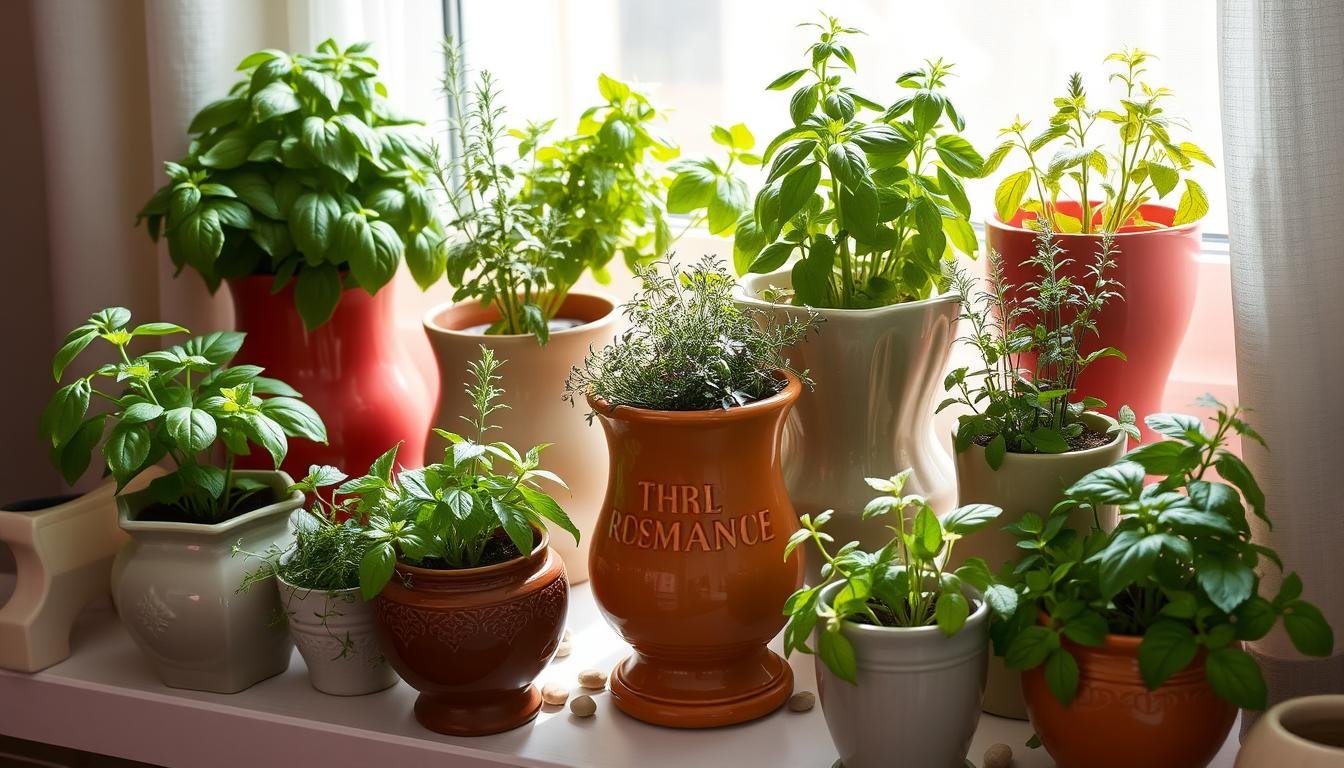Turn your home into a lush green space with the perfect indoor herb garden planters. The right containers and some basic knowledge can give you fresh herbs all year. This boosts your cooking and brings nature indoors.
Indoor herb garden pots let you grow many herbs on your kitchen counter. This means fresh flavors are always ready for you. You can find everything from high-tech AeroGarden Harvest Elite Herb Garden for about $106 on Amazon to stylish inbloom Hydroponics Growing System for $50. There’s a planter for every budget and style.
Choosing kitchen herb garden planters is a smart move. It saves you money and is better for the planet. Plus, these planters make your home look fresh and lively, fitting any decor.
Table of Contents
Choosing the Right Location for Your Indoor Herb Garden
Finding the perfect spot for your indoor herb garden is key to its success. Knowing how much light your herbs need is very important.
South- or West-Facing Windows
South- or west-facing windows are best for herbs that love sunlight. These spots give herbs like basil, rosemary, and sage the six to eight hours of direct sunlight they need. Placing your herb garden here ensures your plants grow well and taste great.
North- or East-Facing Windows
Herbs like chives, mint, and parsley prefer softer light. North- or east-facing windows are perfect for them. These windows offer gentle light, which is just right for herbs that don’t need a lot of sun. This setup keeps your herbs healthy without too much harsh light.
Using Grow Lights for Insufficient Sunlight
In winter or places with little natural light, grow lights are a must. They provide the light your herbs need for photosynthesis. Place grow lights above your herbs to fill any light gaps and help them keep growing.
Things like temperature and humidity also affect your indoor herb garden’s health. Keeping the environment consistent, like outdoor conditions, will help your herbs thrive.
Types of Herb Garden Planters
Choosing the right planters for your indoor herb garden is key. It affects your herbs’ health and your space’s look. We’ll look at terracotta, self-watering, and vertical herb garden planters.
Terracotta Herb Planters
Terracotta herb planters are loved for their timeless beauty. They’re made of a material that lets water and air reach the roots. This is great for herbs like basil and thyme.
They also bring a rustic charm to your home. This makes them a popular choice for many gardeners.
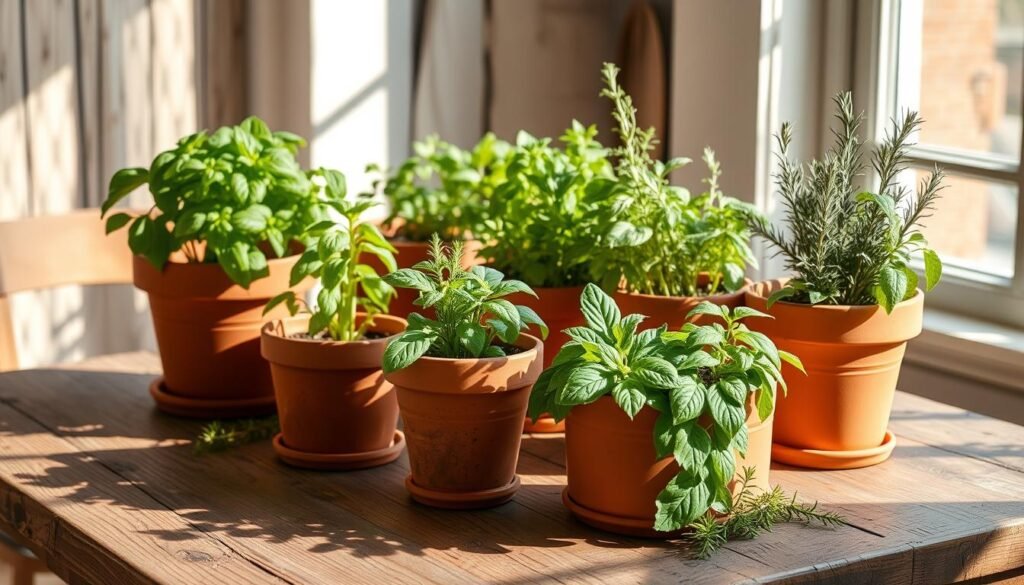
Self-Watering Herb Planters
Self-watering herb planters are perfect for busy people. They have built-in water reservoirs. This means your herbs stay moist without needing constant watering.
These planters are great for herbs like parsley. They save you time and effort. Products like Crescent Garden’s slat planter box help keep plants moist.
Vertical Herb Garden Ideas
Vertical herb gardens are great for small spaces. They let you grow many herbs without taking up much room. You can use pallets or hanging baskets to create them.
These gardens are perfect for balconies or walls. They make your space look green and organized. Plus, they ensure your herbs get enough sunlight.
Best Herbs for Indoor Gardening
Choosing the right herbs for indoor gardening is key. Some need lots of sunlight, while others can handle less. Knowing this helps you make the most of your patio herb planters and indoor spots.
Herbs that Require Full Sun
Herbs like basil, thyme, and rosemary love full sunlight. They need at least six hours of direct sunlight daily. Place them in southern or western windows for the best light.
If your space is too dark, grow lights can help. Use them for 12 to 16 hours a day.
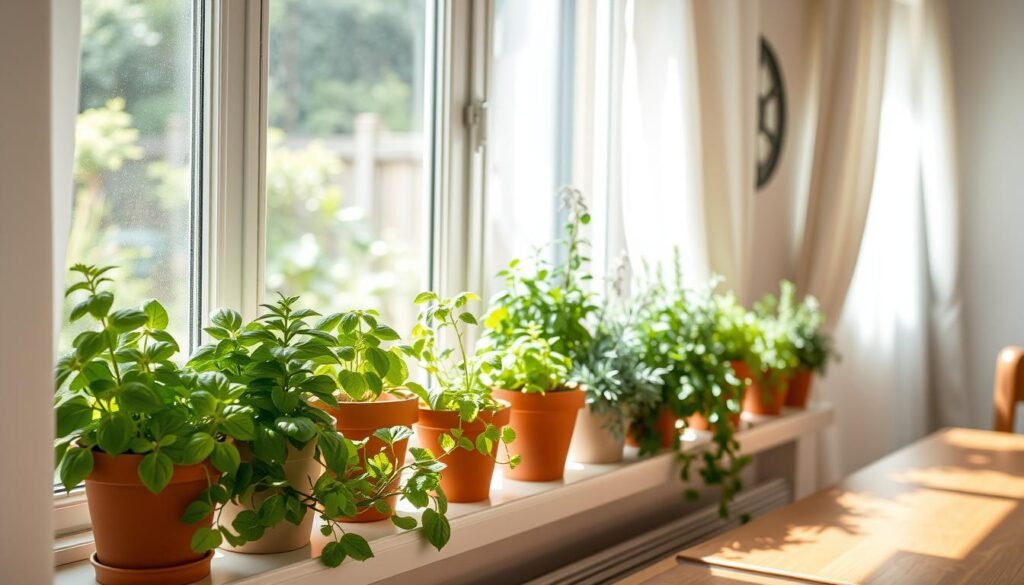
Herbs that Thrive in Partial Sun or Shade
Mint and chives prefer less light. They’re happy with four to six hours of sunlight. East or west windows are great for them.
These herbs also like cooler temperatures. Keep your indoor space between 65 to 75 degrees Fahrenheit.
To help your herbs grow, keep the air moist and circulate well. A fan can help, but not too close. With these tips, your indoor and patio herb planters will flourish.
Starting your indoor herb garden in early spring is a good idea. Use a good potting mix for the best results. Happy gardening!
Soil and Drainage: Key to Healthy Herbs
When you grow an indoor herb garden, knowing what your herbs need in terms of soil is key. You also need to make sure the soil drains well to avoid root rot and other problems. The right mix of soil and how it handles water will greatly affect your herbs’ health and growth.
- Basil: Needs soil that drains well and should be watered once a week to keep it cool and slightly moist.
- Chives: Do best in soil that dries out completely between waterings. They need a good soaking once or twice a week.
- Cilantro: Needs about an inch of moisture around its base at all times. This shows how important a balanced watering schedule is.
- Dill: Prefers soil that stays damp to a depth of one to two inches. Adjust watering based on how much rain you get.
- Fennel: Needs consistent moisture. Adjust watering based on how much rain you get.
- Mint: Needs to be watered every day to keep the soil moist. But, it’s essential to avoid overwatering.
- Oregano: Does best with less frequent, thorough watering. Make sure the soil dries out between waterings.
- Parsley: Prefers damp soil to a depth of two inches. Water once or twice a week.
- Rosemary: Should be watered every one to two weeks to avoid root rot and saturation.
- Sage: Tolerates drought well. Water only when the soil is dry.
- Thyme: Needs very little water, ideally every 10–15 days. This makes it great for colder months.
Choosing the right soil for your raised herb garden beds is essential for their success. Over 60% of herb varieties prefer specific soil moisture levels. This shows how important it is to tailor care to your container garden. For more details, check out this guide on growing herbs in different conditions by clicking here.
Here’s a comparison to help you understand better:
| Herb | Watering Frequency | Growth Duration | Special Requirements |
|---|---|---|---|
| Basil | Weekly | 4-5 days to sprout | Well-draining soil |
| Chives | Once or twice a week | 14-21 days to sprout | Soil must dry completely between waterings |
| Mint | Daily | 10-15 days to sprout | Keep soil moist; do not overwater |
| Rosemary | Every 1-2 weeks | 42 days to sprout | Prevent root rot by avoiding saturation |
By ensuring your raised herb garden beds have the right soil, you’ll see healthier growth and less maintenance. With these tips in mind, your indoor herb garden will flourish. You’ll have fresh, flavorful herbs all year round.
Watering Tips for Indoor Herb Gardens
Keeping the right moisture level is key for healthy indoor herbs. Knowing the watering needs of your herb planter boxes helps your plants thrive all year.
Herbs like mint need daily watering to stay moist. On the other hand, thyme and sage do well with less water, needing it only every 10-15 days.
Here are some tips for watering indoor herbs well:
- Basil: Water once a week when it’s in full sun.
- Chives: Water once or twice a week, letting the soil dry out between.
- Cilantro: Keep the soil around the plant’s base moist.
- Dill: Keep the soil damp, adjusting for rain.
- Fennel: Water when the top inch of soil is dry.
- Oregano: Water thoroughly but not too often.
- Parsley: Water once or twice a week, keeping the soil damp to two inches deep.
- Rosemary: Water every one to two weeks, if it gets enough sunlight.
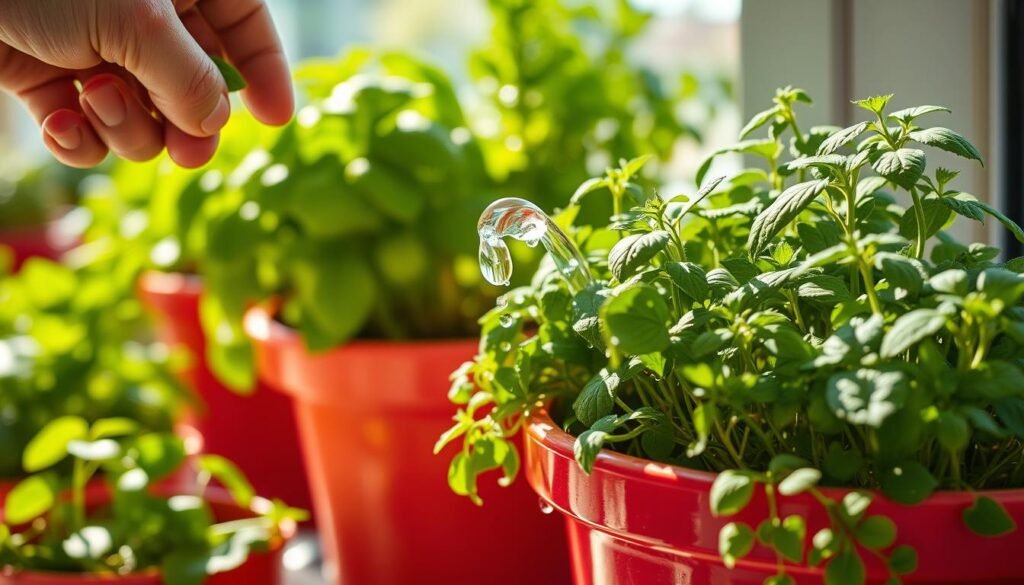
Make sure to water most herbs only when the top soil feels dry. Adjusting your watering schedule for each herb helps avoid overwatering and promotes growth.
Choosing the right containers, like self-watering herb planter boxes, helps keep plants moist. A good plant app can also remind you when to water and offer care tips, making it easier.
| Herb | Watering Frequency | Other Notes |
|---|---|---|
| Mint | Daily | Keep the soil moist at all times. |
| Basil | Once weekly | Water thoroughly. |
| Thyme | Every 10-15 days | Tolerates minimal watering. |
| Sage | When soil is dry | Drought-tolerant. |
| Oregano | Less-frequent watering | Ensure moisture without overwatering. |
Effective watering indoor herbs means balancing moisture with regular checks and the right tools. This creates a thriving herbal space in your home.
DIY Herb Garden Planter Ideas
Creating a DIY herb garden is a fun project that mixes creativity with usefulness. You can use old items or simple containers to make a beautiful and useful herb garden at home.
Repurposed Containers
Turning everyday items into herb planters saves money and adds a personal touch. Old teapots, tin cans, or boots can become unique planters. Just remember to drill holes for drainage to avoid waterlogged soil.
Using a Galvanized Steel Utensil Caddy
Using a galvanized steel utensil caddy is another creative idea. These caddies have separate sections for different herbs. Add small rocks for drainage and use a good potting mix. It’s a space-saving and attractive way to garden.
Simple Container Garden Projects
For beginners, starting with simple projects is a good way to begin. Use wooden boxes or ceramic pots to create a small garden. For a detailed guide on building a raised herb planter, check out this tutorial.
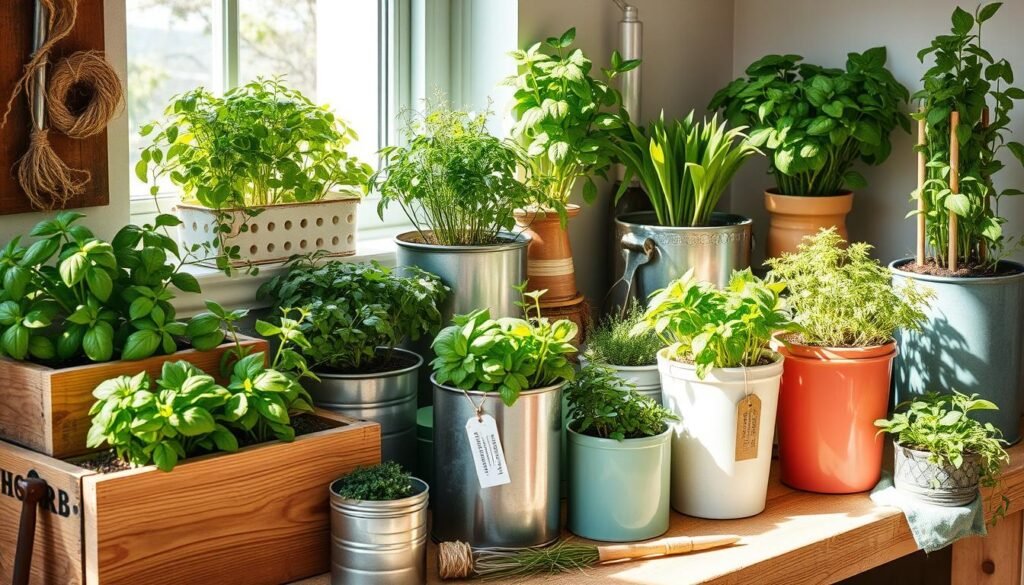
| Component | Materials | Quantity |
|---|---|---|
| Frame | 2×2 lumber | 8 pieces |
| Planter Beds | 2 pieces cedar boards (1x4x10′) | 7 pieces cedar tongue and groove (1x6x12′) |
| Lattice Panel | 4×8′ lattice panel | 1 panel |
| Hardware | 3″ and 1⅝” exterior screws | Multiple |
| Tools | Miter saw, table saw, drill, square | Various |
| Additional Tips | Installation of drainage holes, adding rocks for drainage | N/A |
Herb Garden Planters: What to Look For
When picking herb garden planters, think about the material, size, and design. These factors greatly impact your herbs’ health and growth, more so indoors.
Material: Each material has its own benefits and drawbacks. Terra cotta pots are great because they breathe and prevent waterlogging. This is perfect for many indoor herbs. On the other hand, plastic is light and keeps moisture longer. This is good for herbs like rosemary and basil that need steady water. Learn more about choosing the right pot for your herbs to thrive.
Size: The size of your planters should match your herbs’ growth habits. For example, basil needs more space because of its height and leafiness. Thyme or parsley, being more compact, require less space. Also, consider the root systems of your herbs. Some, like oregano or mint, spread out a lot and should be in separate pots.
| Herb Type | Preferred Planter Size | Suitable Materials |
|---|---|---|
| Basil | Large | Terra cotta, Plastic |
| Rosemary | Medium | Terra cotta, Ceramic |
| Parsley | Small | Plastic, Metal |
| Cilantro | Medium | Terra cotta, Resin |
| Oregano | Medium | Metal, Terra cotta |
Design: The design of your planters can make your indoor herb garden look good while meeting your herbs’ needs. Self-watering planters are great for those who forget to water. They keep the soil moist. Also, pick planters with drainage holes to avoid root rot, which is common in herbs like thyme and sage.
When choosing herb planters, think about the sunlight your indoor space gets. South- or west-facing windows are best for herbs that need full sun. North- or east-facing spots might need grow lights to keep your herbs healthy.
Maintaining Your Indoor Herb Garden Planters
Keeping your indoor herb garden in top shape needs regular care and attention. First, choose the right spot for your planters. They should be near windows that get lots of sunlight, like south- or southwest-facing ones. Herbs like oregano, parsley, rosemary, thyme, and sage need 6 to 8 hours of direct sun each day.
If your home doesn’t get enough sunlight, consider using full-spectrum grow lights. These lights can give your herbs the light they need to grow well.
Managing water and humidity is also key. Different herbs need different amounts of water. For example, basil and parsley like moist soil, while rosemary and sage prefer it drier. Always check the soil moisture before watering again.
Watering deeply and letting the soil dry out between waterings helps prevent root rot. Also, make sure to empty any water that collects in saucers to avoid waterlogged plants.
Trimming and harvesting your herbs regularly is important. It keeps them healthy and encourages new growth. Trimming basil often helps it stay bushy and prevents it from flowering, which can make it taste bitter.
For tips on keeping your herb garden thriving, check out Better Homes & Gardens. Using these strategies will help you grow a beautiful and useful indoor herb garden.

